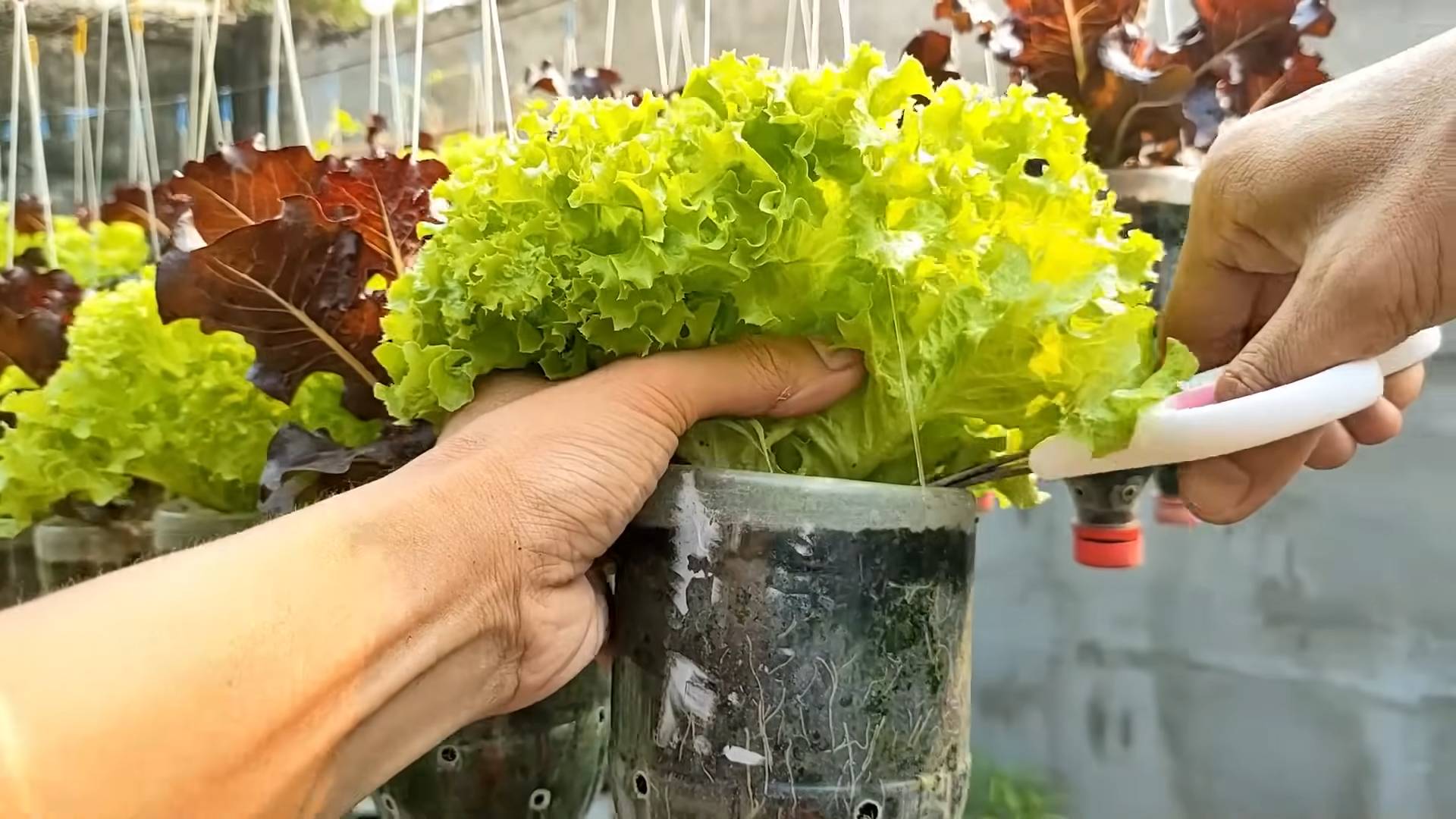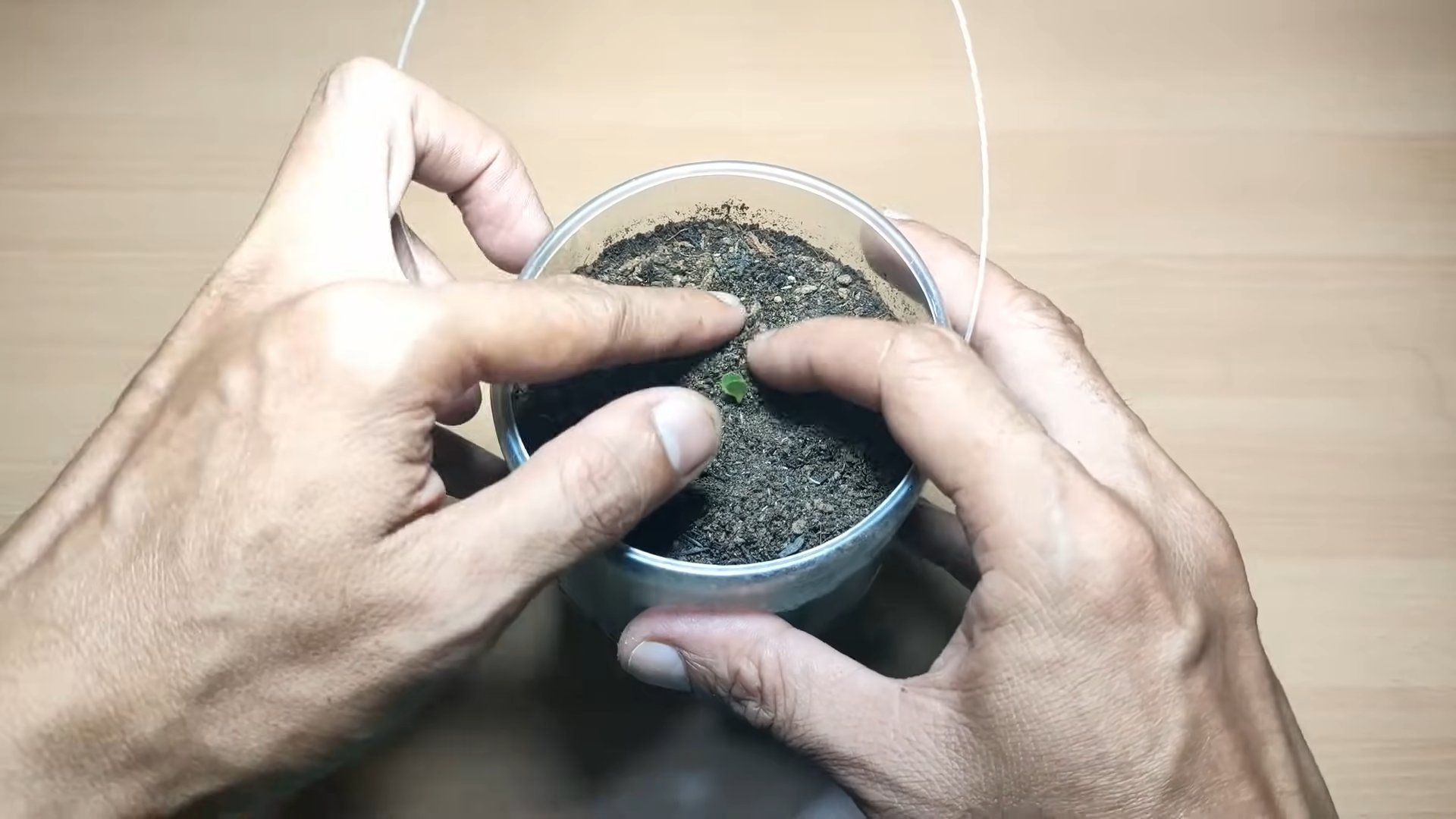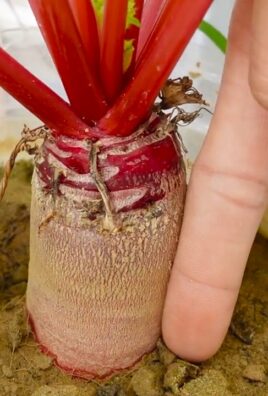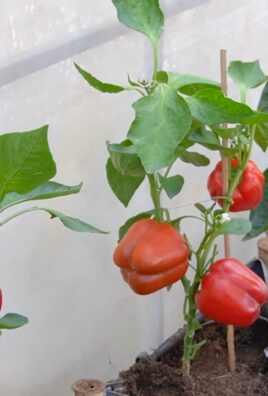Grow Lettuce Indoors? Absolutely! Imagine fresh, crisp lettuce available right at your fingertips, no matter the season. Forget those sad, wilted greens from the grocery store – we’re talking vibrant, flavorful lettuce grown with your own two hands, right in your home. For centuries, people have cultivated gardens, finding solace and sustenance in nurturing plants. While large outdoor gardens are fantastic, the beauty of indoor gardening is its accessibility. Whether you live in an apartment, have limited outdoor space, or simply want a year-round supply of your favorite greens, growing lettuce indoors is the perfect solution.
But why should you bother with this DIY project? Well, think about it: you control the environment, ensuring optimal growing conditions. No more battling pests, unpredictable weather, or soil deficiencies. Plus, it’s incredibly rewarding to watch those tiny seeds sprout and transform into a delicious salad. I’m going to show you some simple, effective tricks and hacks that will make growing lettuce indoors a breeze, even if you’ve never gardened before. Get ready to enjoy fresh, homegrown lettuce whenever you crave it!

Grow Your Own Salad: A Beginner’s Guide to Indoor Lettuce Gardening
Hey there, fellow plant enthusiasts! Ever dreamt of having fresh, crisp lettuce right at your fingertips, no matter the season? Well, dream no more! I’m going to walk you through the surprisingly simple process of growing lettuce indoors. It’s easier than you think, and the reward of a homegrown salad is totally worth it.
Choosing the Right Lettuce Variety
First things first, not all lettuce varieties are created equal when it comes to indoor growing. Some thrive under artificial light and in smaller spaces better than others. Here are a few of my personal favorites:
* Loose-leaf varieties: These are your best bet for beginners. They mature quickly and you can harvest leaves as needed, rather than waiting for the entire head to form. Think ‘Black Seeded Simpson’, ‘Red Sails’, or ‘Oak Leaf’.
* Butterhead lettuce: These are also a good option, offering a slightly sweeter flavor and a softer texture. ‘Buttercrunch’ and ‘Tom Thumb’ are popular choices.
* Romaine lettuce: While possible to grow indoors, romaine can be a bit more challenging as it requires more light. If you’re up for the challenge, give it a try!
Gathering Your Supplies
Before we get our hands dirty, let’s make sure we have everything we need. Here’s a checklist:
* Lettuce seeds: Choose your favorite variety, or even a mix for a diverse salad!
* Containers: You can use anything from plastic pots to repurposed containers like yogurt tubs or even old salad containers. Just make sure they have drainage holes. I personally love using rectangular planters as they maximize space.
* Potting mix: Use a high-quality, well-draining potting mix. Avoid using garden soil, as it can be too heavy and compact for indoor containers. Seed starting mix is also a good option for starting seeds.
* Grow lights: This is crucial for indoor lettuce growing. Lettuce needs at least 12-14 hours of light per day. Fluorescent shop lights or LED grow lights work well.
* Watering can or spray bottle: For gentle watering.
* Optional: Seed starting tray and humidity dome: These are helpful for starting seeds indoors, but not essential.
* Optional: Liquid fertilizer: A balanced liquid fertilizer can help boost growth, but it’s not always necessary.
Planting Your Lettuce Seeds
Now for the fun part! Let’s get those seeds in the soil.
1. Prepare your containers: Fill your chosen containers with potting mix, leaving about an inch of space at the top. Gently pat down the soil.
2. Sow the seeds: Sprinkle the lettuce seeds evenly over the surface of the soil. Lettuce seeds are tiny, so don’t overcrowd them. A good rule of thumb is to space them about ½ inch apart.
3. Cover the seeds: Lightly cover the seeds with a thin layer of potting mix, about ¼ inch deep.
4. Water gently: Use a spray bottle or watering can to gently moisten the soil. Be careful not to wash the seeds away.
5. Create a humid environment (optional): If you’re using a seed starting tray and humidity dome, place the containers inside. This will help keep the soil moist and promote germination. If not, you can cover the containers with plastic wrap, making sure to poke a few holes for ventilation.
6. Place under grow lights: Position your containers under the grow lights, about 2-4 inches away from the light source.
7. Maintain moisture: Keep the soil consistently moist, but not soggy. Check the soil daily and water as needed.
Germination and Seedling Care
Within a week or two, you should start to see tiny lettuce seedlings emerge. This is where the real fun begins!
1. Remove the humidity dome or plastic wrap: Once the seedlings emerge, remove the humidity dome or plastic wrap to allow for better air circulation.
2. Thin the seedlings: If your seedlings are too crowded, thin them out by snipping off the weaker ones at the soil line. This will give the remaining seedlings more room to grow. Aim for a spacing of about 2-3 inches between plants.
3. Adjust the grow lights: As the seedlings grow, you may need to adjust the height of the grow lights to keep them about 2-4 inches away from the top of the plants.
4. Water regularly: Continue to water regularly, keeping the soil consistently moist.
5. Fertilize (optional): If you choose to fertilize, start with a diluted solution of liquid fertilizer about two weeks after germination. Follow the instructions on the fertilizer label. I usually use a half-strength solution to avoid burning the delicate seedlings.
Harvesting Your Lettuce
The best part! Depending on the variety, your lettuce should be ready to harvest in about 30-60 days.
1. Harvest loose-leaf lettuce: For loose-leaf varieties, you can start harvesting individual leaves as soon as they are large enough to eat. Simply snip off the outer leaves with scissors or your fingers, leaving the inner leaves to continue growing. This is called “cut-and-come-again” harvesting, and it allows you to enjoy fresh lettuce for weeks.
2. Harvest butterhead and romaine lettuce: For butterhead and romaine lettuce, you can harvest the entire head when it is fully formed. Cut the head off at the base of the plant.
Troubleshooting
Even with the best care, you might encounter a few challenges along the way. Here are some common problems and how to fix them:
* Leggy seedlings: This means your seedlings are stretching towards the light because they’re not getting enough. Lower the grow lights or provide more light.
* Yellowing leaves: This could be a sign of overwatering, underwatering, or nutrient deficiency. Check the soil moisture and adjust your watering accordingly. If you suspect a nutrient deficiency, try fertilizing with a balanced liquid fertilizer.
* Pests: Indoor lettuce is less prone to pests than outdoor lettuce, but you might still encounter aphids or spider mites. Inspect your plants regularly and treat any infestations with insecticidal soap or neem oil. I usually just wipe them off with a damp cloth.
* Mold: This can be a problem in humid environments. Make sure your plants have good air circulation and avoid overwatering.
Tips for Success
Here are a few extra tips to help you succeed with indoor lettuce gardening:
* Rotate your containers: Rotate your containers regularly to ensure that all sides of the plants receive equal light.
* Provide good air circulation: Good air circulation will help prevent fungal diseases. You can use a small fan to circulate the air around your plants.
* Succession planting: To ensure a continuous supply of fresh lettuce, sow new seeds every few weeks.
* Experiment with different varieties: Try growing different varieties of lettuce to find your favorites.
* Enjoy the process! Growing your own lettuce is a rewarding experience. Don’t be afraid to experiment and have fun!
Choosing the Right Grow Light
Selecting the right grow light is crucial for successful indoor lettuce cultivation. Lettuce requires a good amount of light to thrive, and the type of light you provide can significantly impact its growth and flavor. Here’s a breakdown of the most common grow light options:
* Fluorescent Lights: These are a budget-friendly option, especially T5 fluorescent grow lights. They provide a broad spectrum of light that’s suitable for lettuce growth. They are relatively energy-efficient and don’t produce excessive heat, making them a good choice for smaller setups. I started with these!
* Pros: Affordable, energy-efficient, low heat output.
* Cons: Less intense than other options, may need to be placed closer to the plants.
* LED Grow Lights: LEDs are becoming increasingly popular due to their energy efficiency, long lifespan, and customizable light spectrum. You can find LED grow lights specifically designed for leafy greens, offering the optimal wavelengths for photosynthesis.
* Pros: Highly energy-efficient, long lifespan, customizable spectrum, low heat output.
* Cons: Can be more expensive upfront.
* Incandescent Lights: I would avoid these. They are not energy efficient and produce too much heat.
* Placement: Regardless of the type of light you choose, proper placement is essential. Position the light source 2-4 inches above the lettuce seedlings. As the plants grow, adjust the height of the light to maintain this distance.
Choosing the Right Container
The container you choose for your indoor lettuce garden can impact drainage, root growth, and overall plant health. Here’s a guide to selecting the right container:
* Size: Lettuce doesn’t require deep containers, as its root system is relatively shallow. A container that is at least 6 inches deep is sufficient. The width and length of the container will depend on how

Conclusion
So, there you have it! Growing lettuce indoors is not only achievable but also incredibly rewarding. Forget those limp, overpriced greens from the grocery store. With a little effort and the right setup, you can enjoy fresh, crisp lettuce right from your own home, all year round. This DIY trick is a must-try for anyone looking to add a touch of green to their living space, improve their diet, and reduce their reliance on store-bought produce.
Why is this method so compelling? Firstly, it offers unparalleled freshness. Imagine snipping off exactly the amount of lettuce you need for your salad, just moments before you eat it. The flavor and texture are simply unmatched. Secondly, it’s incredibly convenient. No more last-minute trips to the store when you realize you’re out of lettuce. Your salad ingredients are always within arm’s reach. Thirdly, it’s a sustainable choice. By growing your own lettuce, you’re reducing your carbon footprint associated with transportation and packaging.
But the benefits don’t stop there. Growing lettuce indoors can also be a therapeutic and enjoyable hobby. Watching your seedlings sprout and mature is a truly satisfying experience. It’s a great way to connect with nature, even in the heart of the city. Plus, it’s a fantastic educational opportunity for kids, teaching them about plant life cycles and the importance of healthy eating.
Ready to take your indoor gardening to the next level? Consider experimenting with different varieties of lettuce. Romaine, butterhead, and loose-leaf varieties all thrive indoors. You can also try growing other leafy greens alongside your lettuce, such as spinach, arugula, or kale. For an added boost, consider using a hydroponic system for even faster and more efficient growth. You can even explore companion planting, adding herbs like basil or chives to deter pests and enhance flavor.
Don’t be afraid to experiment with different lighting setups. While a sunny windowsill can work, supplemental grow lights can significantly improve your lettuce’s growth and yield, especially during the darker winter months. LED grow lights are energy-efficient and provide the perfect spectrum of light for leafy greens.
We encourage you to give this DIY trick a try. It’s easier than you might think, and the rewards are well worth the effort. Once you’ve harvested your first batch of homegrown lettuce, be sure to share your experience with us! Post photos of your indoor lettuce garden on social media using #IndoorLettuceGarden and tell us about your favorite varieties and growing tips. We can’t wait to see your green thumbs in action! Let’s create a community of indoor gardeners and inspire others to grow their own food. Embrace the joy of fresh, homegrown lettuce and discover the satisfaction of nurturing your own little garden oasis indoors. This method of growing lettuce indoors is a game changer.
Frequently Asked Questions (FAQ)
What kind of lettuce grows best indoors?
Loose-leaf varieties like Black Seeded Simpson, Salad Bowl, and Red Sails are generally considered the easiest to grow indoors. They mature quickly and can be harvested continuously. Butterhead varieties like Buttercrunch and Romaine lettuce also do well, but may take a bit longer to mature. Experiment to see which varieties you prefer and which thrive best in your specific indoor environment.
How much light does indoor lettuce need?
Lettuce needs at least 6 hours of direct sunlight per day. If you don’t have a sunny windowsill, you’ll need to supplement with grow lights. LED grow lights are a great option because they are energy-efficient and provide the right spectrum of light for leafy greens. Position the lights a few inches above the plants and adjust as they grow.
What kind of soil should I use for growing lettuce indoors?
Use a well-draining potting mix that is rich in organic matter. You can also add compost or worm castings to improve the soil’s fertility. Avoid using garden soil, as it can be too heavy and may contain pests or diseases. A mix of peat moss, perlite, and vermiculite is a good option.
How often should I water my indoor lettuce?
Keep the soil consistently moist, but not soggy. Water when the top inch of soil feels dry to the touch. Avoid overwatering, as this can lead to root rot. Use a watering can or spray bottle to water gently, avoiding getting the leaves wet.
How do I harvest lettuce from my indoor garden?
You can harvest lettuce leaves as soon as they are large enough to eat. For loose-leaf varieties, simply snip off the outer leaves, leaving the inner leaves to continue growing. For head lettuce varieties, you can harvest the entire head when it is mature.
What are some common problems when growing lettuce indoors?
Common problems include pests, diseases, and nutrient deficiencies. Aphids, spider mites, and whiteflies are common pests that can infest indoor lettuce. Inspect your plants regularly and treat any infestations promptly with insecticidal soap or neem oil. Diseases like powdery mildew and downy mildew can also affect lettuce. Ensure good air circulation and avoid overwatering to prevent these diseases. Nutrient deficiencies can cause yellowing or stunted growth. Use a balanced fertilizer to provide your lettuce with the nutrients it needs.
Can I grow lettuce indoors year-round?
Yes, you can grow lettuce indoors year-round, provided you have adequate light and temperature control. During the winter months, you may need to supplement with grow lights to provide enough light. Keep the temperature between 60-70°F (15-21°C) for optimal growth.
How do I prevent my lettuce from bolting (going to seed)?
Bolting is when lettuce plants prematurely produce a flower stalk and become bitter. It is often caused by high temperatures or stress. To prevent bolting, keep the temperature cool, provide adequate water, and harvest regularly. Choose bolt-resistant varieties for best results.
Can I grow lettuce indoors hydroponically?
Yes, growing lettuce hydroponically is a great option for indoor gardening. Hydroponics allows you to grow lettuce without soil, using a nutrient-rich water solution. This can result in faster growth and higher yields. There are many different hydroponic systems available, from simple DIY setups to more advanced commercial systems.
What kind of fertilizer should I use for indoor lettuce?
Use a balanced fertilizer that is specifically formulated for leafy greens. Look for a fertilizer with a ratio of 10-10-10 or similar. You can also use organic fertilizers like compost tea or fish emulsion. Follow the instructions on the fertilizer label carefully to avoid over-fertilizing.




Leave a Comment